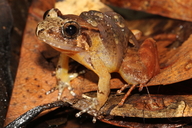|
Description
We need a species account! Contact us if you are interested in writing for AmphibiaWeb.
Distribution and Habitat
Country distribution from AmphibiaWeb's database: Indonesia, Malaysia, Philippines Malaysian region distribution from AmphibiaWeb's database: Sabah, Sarawak
Comments
This species was featured as News of the Week:
January 8, 2019: Sex role reversal, in which the time, effort and risk invested in offspring by male parents exceeds that of females, is a rare phenomenon with important implications for sexual selection theory. Under sex role reversal, males invest so much time and effort into caring for offspring that they become a limiting resource for females, and females actively compete for access to potential mates. Previous research has identified sex role reversal in a few birds (e.g. jacanas) and insects (e.g. Australian kaytidids in the family Tettigoniidae). In amphibians, evidence has been sparse. In the Majorcan midwife toad, males care for clutches of eggs wrapped around their legs, and there is some evidence that females actively court and compete for males. New research provides evidence that sex role reversal may occur in Palawan Wart Frog from Borneo, Limnonectes palavensis. Goyes Vallejos et al. (2017) found that female Limnonectes palavensis called more frequently than males, and that multiple females would approach individual males and call to them. Subsequently Goyes Vallejos et al. (2018) demonstrate that males spend long periods of time caring for their offspring. They do not attempt to leave the area or search for new mates while caring for a clutch. While further evidence is needed to conclusively demonstrate sex role reversal, this species provides one of the best candidates for this phenomenon in frogs to date. (Written by Kyle Summers)
August 14, 2017: Frog calls are typically only produced by males, with the females of some species occasionally responding. However, while studying Limnonectes palavanensis, Vallejo et al. (2017) found that advertisement calls were primarily produced by females. Males also had advertisement and courtship calls, but they only produced them sporadically. The authors also found that females aggregate and call around a single male in a lek-like formation in which the male chooses a female. Lastly, after laying eggs, females leave males to guard eggs and transport tadpoles. All of these behaviors together demonstrate the first known instance of a sex-role-reversal mating system in amphibians. (Written by Ann Chang)
Originally submitted by: Michelle S. Koo (first posted 2019-08-02)
Species Account Citation: AmphibiaWeb 2019 Limnonectes palavanensis: Palawan Wart Frog <https://amphibiaweb.org/species/4787> University of California, Berkeley, CA, USA. Accessed May 11, 2025.
Feedback or comments about this page.
Citation: AmphibiaWeb. 2025. <https://amphibiaweb.org> University of California, Berkeley, CA, USA. Accessed 11 May 2025.
AmphibiaWeb's policy on data use.
|





 Map of Life
Map of Life